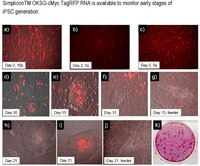SCR729 MilliporeHuman OKSG-cMyc TagRFP Simplicon™ Plasmid
MilliporeSigma’s Human OKSG-cMyc TagRFP Simplicon™ Plasmid allows you to produce unlimited amount of Human OKSG-cMyc TagRFP Simplicon™ RNA for human iPSCs generation along with a red fluorescent protein (TagRFP).
More>> MilliporeSigma’s Human OKSG-cMyc TagRFP Simplicon™ Plasmid allows you to produce unlimited amount of Human OKSG-cMyc TagRFP Simplicon™ RNA for human iPSCs generation along with a red fluorescent protein (TagRFP). Less<<Produits recommandés
Aperçu
| Replacement Information |
|---|
| References |
|---|
| Product Information |
|---|
| Biological Information | |
|---|---|
| Concentration | Please refer to lot specific datasheet. |
| Physicochemical Information |
|---|
| Dimensions |
|---|
| Materials Information |
|---|
| Toxicological Information |
|---|
| Safety Information according to GHS |
|---|
| Safety Information |
|---|
| Storage and Shipping Information | |
|---|---|
| Storage Conditions | Human OKSG-cMyc TagRFP Simplicon™ Plasmid (Cat. # CSR729). One (1) vial containing 10 µL of Plasmid (1 µg/µL). Store at -20 °C |
| Packaging Information | |
|---|---|
| Material Size | 1 vial |
| Transport Information |
|---|
| Supplemental Information |
|---|
| Specifications |
|---|
| Global Trade Item Number | |
|---|---|
| Référence | GTIN |
| SCR729 | 04054839501722 |
Documentation
Human OKSG-cMyc TagRFP Simplicon™ Plasmid FDS
| Titre |
|---|
Fiche technique
| Titre |
|---|
| Human OKSG-cMyc TagRFP Simplicon¿ Plasmid |
Manuels d'utilisation
| Titre |
|---|
| SimpliconTM Expression System: Designing Cloning and RNA Synthesis for Expression of Self-Replicative RNA |
Séquence du vecteur
| Titre |
|---|
| Human OKSG-cMyc TagRFP Simplicon Plasmid |







